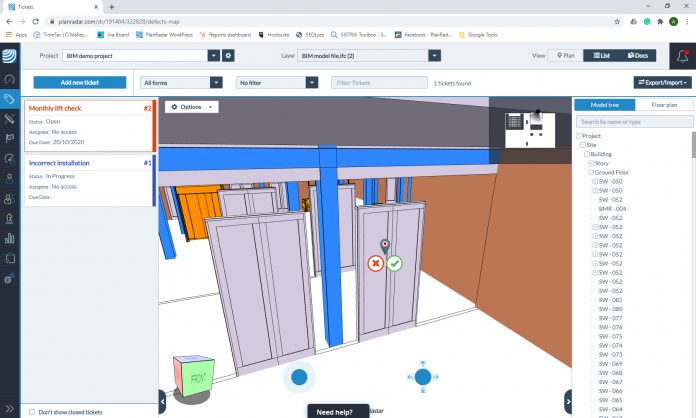Sander van de Rijdt, co-founder and managing director of PlanRadar, takes a look at whether BIM Level 2 implementation has worked in the UK
When the UK launched its Construction Strategy 2016-20, one of the most eye-catching features was that construction firms had to be BIM level 2 certified to work on government projects (or at least be working towards certification). Now that this period is over, BIM Level 2 should, in theory, be widespread in the industry. So, has this drive towards raising BIM levels been a success?
What is BIM Level 2?
The phrase BIM level 2 describes smart projects where 3D BIM models detail every characteristic of a building or engineering project. Besides using 3D modelling, it also emphasises improved collaboration where all key stakeholders can contribute based on their own specialism and have a shared view of the project. The government encouraged the construction industry to implement BIM Level 2 as part of its Digital Built Britain drive which seeks to improve processes and make the building industry more efficient.
During the next phase of the strategy, construction firms will need to work towards BIM Level 3 by 2025. This level requires every worker on a building project to have access to building information modelling apps where they can see the project and tasks that they must complete.
One example of BIM level 2 in action is the case of Cookham And Wood Prison, where the contractor was invited to propose an internal redesign of the facility. To improve visibility and illumination inside the prison, they suggested the use of reinforced glass, rather than traditional metal bars. During the initial proposal, the prison’s governor accepted this idea.
However, once the designers created a BIM model, the governor realised that glass would prevent sound travelling through space. This is important for prison security guards who want to monitor behaviour. As a result, the contractor and client chose metal bars instead. Use of BIM level 2 ensured that designers could detect this problem early on and avoided expensive refits later.
Where has BIM Level 2 been a success?
 Generally speaking, the deployment of BIM Level 2 has been received positively in the industry. Many more firms are now using BIM software, and case studies report that it has saved time and money on thousands of building projects. The approach has a track record of improving building projects where savings in several different areas.
Generally speaking, the deployment of BIM Level 2 has been received positively in the industry. Many more firms are now using BIM software, and case studies report that it has saved time and money on thousands of building projects. The approach has a track record of improving building projects where savings in several different areas.
Cost savings: As BIM Level 2 uses 3D modelling for clash detection, thousands of projects have saved significant sums of money by identifying and resolving issues early. For example, on one road-building project BIM models identified 360 issues that would not have been discovered otherwise. A PwC study shows that the average cost of clash rectification would have been £2,500, meaning that BIM saved the project some £900,000 in total.
Time savings: Using BIM models can save businesses a huge amount of time. PwC suggests that simply having access to centralised models reduces time spent searching for and sharing asset information by 70%. They also identified several projects where reviews of models helped project teams discover problems early that could have caused disruption.
Material savings: One key benefit of BIM models is that they can reduce waste from construction sites. PwC’s research describes how one ice rink project used a BIM model to accurately calculate how much material would be needed and therefore avoided purchasing surplus material. This prevented hundreds of tons of wasted material.
While adoption of BIM level 2 has gradually increased in the UK over the last four years and there are plenty of case studies highlighting success, the wider picture of adoption suggests there is some way still to go. impressive. For example, in a recent survey of construction industry professionals, while 47% responded to say they feel the government is “on the right track” with BIM, 44% said that the implementation of BIM level 2 on government projects has not been very successful. As well as this, only 4% believe it has been a very positive experience, with two-fifths of survey respondents reported that they still did not know how to comply with the rules. What’s more, many say that a lack of in-house knowledge or experience is holding them back from compliance.
Yet, of the 800 surveyed, nearly three quarters were “aware and using” BIM, with just 1% now unaware of the modelling, which did leave some commentators to point to its implementation as being a success.
BIM Level 3
As BIM Level 2 is now seen as the minimum requirement for any company that wishes to collaborate on government projects, it’s increasingly necessary that it continues to meet these standards. With BIM Level 3 compliance expected by 2025, companies must now continue to plan how they will introduce this digital construction technology.
Although it will involve an upfront investment, this should pay dividends in the end. With the current UK government urging firms to “build, build, build”, being BIM Level 3 compliant could open up a pipeline of new work in the future.
How we support all BIM Levels
The most recent Glenigan report on key performance indicators in the UK construction industry shows that 34% of construction projects run over budget and 41% of projects are still delayed. Budget inaccuracies, design errors, scheduling conflicts and miscommunication between stakeholders can all be prevented through greater collaboration with BIM.
Our project management application PlanRadar allows you to import and use BIM models on handheld devices like tablets or smartphones, meaning any contractor can view the 3D representations of your projects and the details of each component in the model. This is a key component of BIM: that you can store a lot of data on specific materials and building elements from the design within the model in components. It makes life easier for those on the construction site, who can clearly see what the engineers and architects have selected for the job. Snags and tasks can also then be located precisely on the model. The software also allows contractors to communicate and collaborate more easily with other project members, reducing data siloes. By bringing accurate, dynamic BIM models to any worker on a project, this feature fully supports firms that wish to meet the requirements of BIM Level 3.
Sander van de Rijdt
Co-founder and managing director
Twitter: @PlanRadarUK
LinkedIn: PlanRadar UK















Shame this article repeatedly refers to BIM Level 3, and makes no mention of the emerging international suite of ISO 19650 standards. The ‘levels’ approach has been superseded in the UK by the UK BIM Framework, launched in October 2019. The Framework provides an overarching approach to BIM implementation in the UK. This single set of guidance includes integration of the BS EN ISO 19650 series, aiming to support industry understanding of BIM standards and their implementation